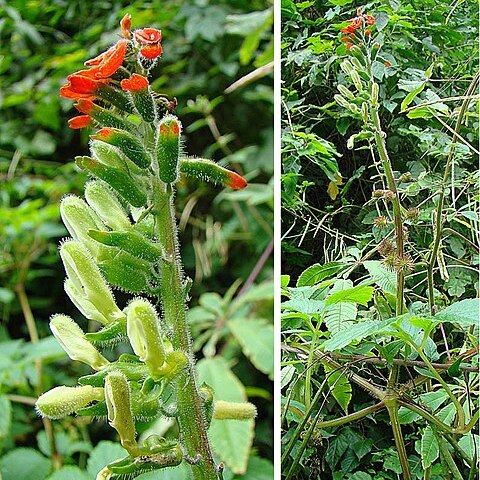spicate but with short pedicels, narrowly bracteate, the bracts scarlet, the terminal flowers mostly sterile with bright red calyces. Flowers with the calyx of fertile flowers 1.3-1.5 cm long, somewhat hirsute, deeply 2-parted more than half its length, the upper lobe long-acuminate, the lower lobe acute, the limbs red; corolla purplish to greenish, tubular, 1.6-1.8 cm long and apically 3-5 cm wide, bilabiate, the tube 1-1.1 cm long, the lip 6-8 cm long, all lobes fused forming a protective hood over the anthers, this open below, pubescent outside, mostly glabrous inside, pubescent at the base of the stamens; stamens 4, the anther thecae divaricate, glabrous, 1-2 mm long, shorter filaments 8-9 mm long, longer filaments 9-11 mm long, staminode absent, inserted 7-8 mm from the base of the tube; pistil 1.4-1.5 cm long, the ovary ovoid, densely short-tuber-culate with thick, single-celled trichomes, 2.5-3 mm long and 1.5 mm wide, 4-celled, the ovules uniseriate in each locule; disc cupular-membranaceous, 1 mm long and 1.5 mm wide; capsule ovoid, somewhat woody, ca. 3.5 cm by 1.7 cm, strongly echinate with long spines to 1 cm long with recurved tips and shorter straight spines, 2-valved, apically septicidally dehiscent, often not splitting to base; seeds thin, flat, 6-7 mm long and 4-5 mm wide, the dark brown body encircled by a narrow brown almost membranaceous wing. This species is a plant of upper elevations from 600 m to 1800 m. It occurs in the wet or moist premontane and lower montane regions from Guatemala to Peru and in the Andes east to just across the Venezuelan border. The fruits are burr-like and are probably epizoochorous with the seeds shaking a few at a time out of the partially opened capsule.
More
Herbaceous vine, the branchlets tetragonal. Leaves opposite, biternate with a subterminal, finely branched, spirally coiling tendril, the leaflets membra-naceous, glabrous, conspicuously and unevenly serrate, 3-8 cm long and 1.5-5 cm wide, the lateral pair of a ternation often divided to base. Inflorescence

